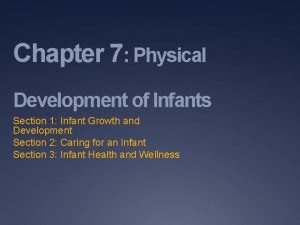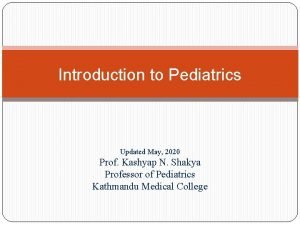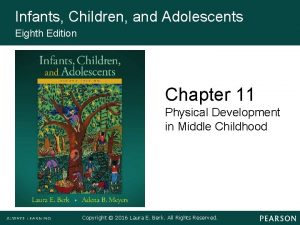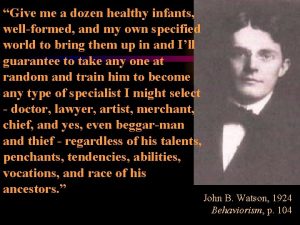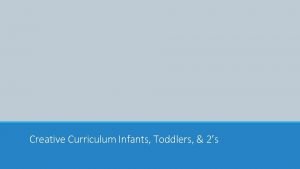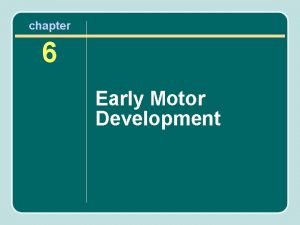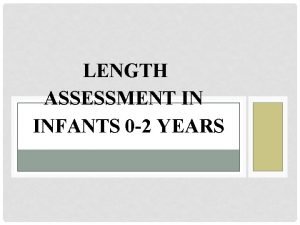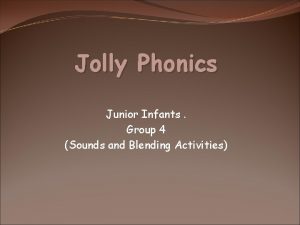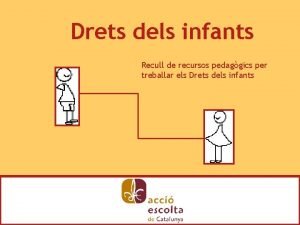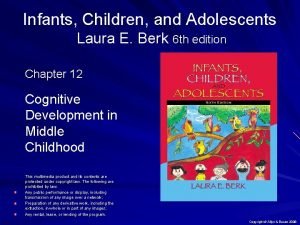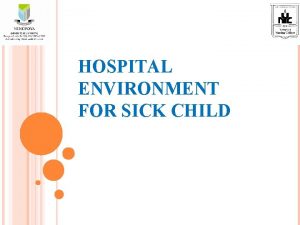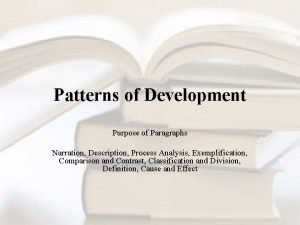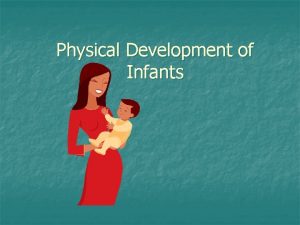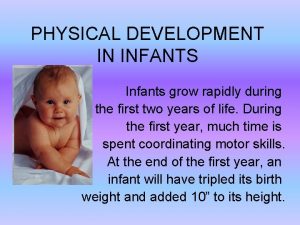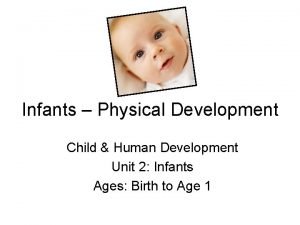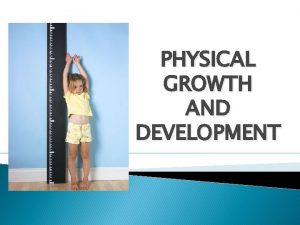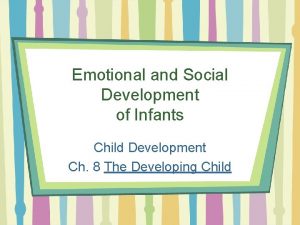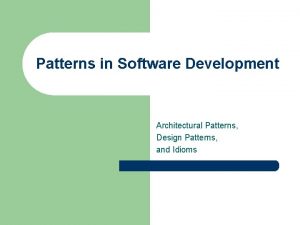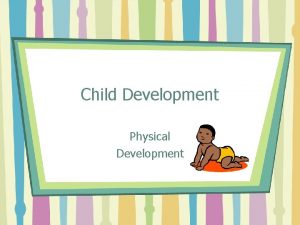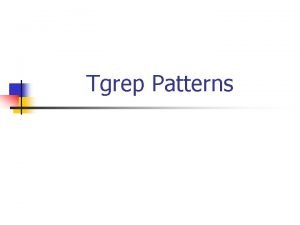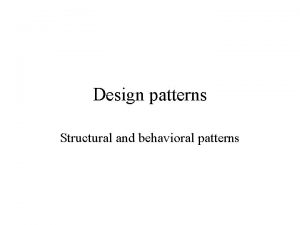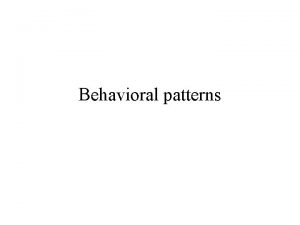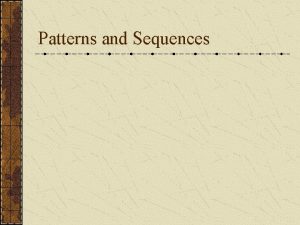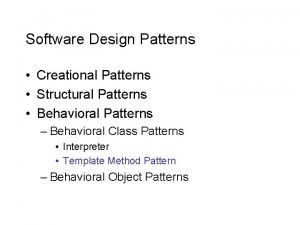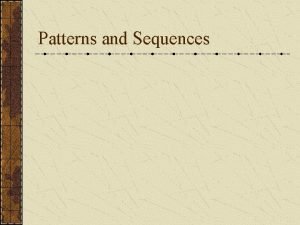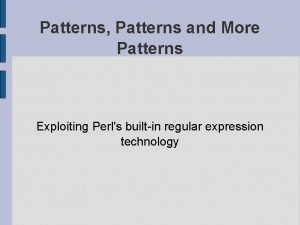Physical Development of Infants Child Development Patterns of






























- Slides: 30

Physical Development of Infants Child Development

Patterns of Physical Development • The pattern of development begins before birth during the prenatal stage. • Head leads in development – Control of head movements • Raise their head to see an object • Next arms and hands • Legs and feet slowly

Patterns of Physical Development cont. • Near to Far • Development begins close to trunk of the body and moves outward – Wave arms when they see an object – Later – development of more precise hand finger control • Can reach and grasp for object with fingers

Patterns of Physical Development cont. • Simple to Complex – First develop large muscle groups • Legs, neck, arms, and torso – Strengthen and gain control over muscles • Through exercise and movement (involuntary) – Learn increasingly complex tasks • Controlling head, rolling, reaching, crawling, and walking

Influences on Growth and Development • Heredity and Environment – significant role • Heredity – Baby inherits from parents • Environment (or “nature”) – More complex • • Nutrition Amount of stimulation Health Relationships

Developmental Milestones • Range of ages to determine the average which children acquire a certain skills. • To reach these milestones infants need to play and have good nutrition to build a strong body. • If a child become ill for an extended period of time and misses out on the play and nutrition it will take them longer to reach the milestones.

Heredity • We already know that our genes are a “blueprint” for the development of the human body that we get from our parents. – Eye and hair color, when teeth first emerge • Genes also influence larger traits like intellectual potential and artistic abilities – Nature also plays a role – if never given what is needed to develop a trait that trait won’t emerge.

Nutrition • Foods with essential nutrients – Key to child’s lifelong health – Coupled with proper amount of sleep • Growing and developing • Proper nutrition fuels development – Research show the affect of nutrition on growth and development. • Bone strength, brain development, and height

Nutrition cont. • Insufficient nutrition – Calories – Nutrients – Risk for illness – Delayed growth – Death

Health • Closely linked to other factors that influence growth and development – Healthy • Eat well – have energy to be active • Varied experiences to stimulate brain and aid in muscle development – Poor health • At risk of falling behind developmentally • Safe environment • Regular medical checkup and care

Experiences • Important key to development – Brain Development • Impacts all areas of development links – Quantity and variety of experiences – Infancy • Critical period – Failure to achieve normal brain development at this stage can have lifelong effects

Environment • Stimulating environment – Wide variety of thing to see, smell, hear, and touch • Toys (w/sound), colors, textures, music – A world with plenty of ways to use all senses provides wonderful opportunities for infant development – Experiences are stored in their brain and make associations • Highchair - food

Environment cont. • Lacking stimulation – Weaker connections in the brain – Delayed or slow development in other areas • born w/o language skills • Beginning from birth connections are made – Part of brain responsible for language – Enabling child to begin speaking » If not exposed to language » Not encouraged to speak – fewer connections to brain » Delay normal language development

Environment cont. • Other factors – Secondhand smoke • Poor health – – Respiratory infections Ear infections Asthma (prenatal smoking mother) » Low birth weight » Premature birth » Predisposed to having allergies

Growth during the first year • From birth to one year babies – Triple their birth weight – Increase in length by 1/2

Growth Charts (different for boys and girls)

Growth Charts • Different for boys and girls • Grow at their own rates • Watch for a steady pattern of growth – Sudden drops in weight could indicate health concerns

Weight • Weight gain best sign of good health • Most newborns lose 10% of birth weight in first 5 days of life • Begin to gain more steadily (& rapidly) – In first 6 months gains about 1 to 2 pounds per month – Average weight of a one year old is 20 – 22 pounds – Boys usually weigh more than girls during “babyhood”

Length Mesurement • In first year babies are measured laying down so it’s called length • After first year toddlers are measured standing so it’s called height

Length • Grow steadily in first year because bone growth is rapid during this time. • Not all babies grow at same rate • Boys slightly longer than girls • Heredity influences

Body Shape Proportion • Hold themselves in tightly curled position when first born. • Babies stretch out within the first six months and are skinny for the most part. • By three months babies look chubby like. • The size relationship between different body parts • Head and abdomen are larger – arms and legs are smaller and short • Head grows rapidly to accommodate developing brain. – Lose the chubbiness as they get longer and more active

Development during first year • Remarkable changes over the first year • Growth and development are quite rapid • During this time period it’s the easiest to see the obvious changes.

Vision • At first blurry • Within a week the newborn becomes increasing aware of their environment. • Focus on items 7 – 10 inches away • Follow an object passing in front of their face • At 1 month can focus on items 3 feet away • 6 months clarity and sharpness (adult level)

Vision cont. • First world is 2 dimensional (like a picture) • 2 nd month demonstrate depth perception (seeing 3 -D) – Significantly impacts children’s interaction with world • Track people as they move • Reach for objects – judging how far away

Vision cont. • Patterns and colors important – Prefer patterns with high contrast • Alternating stipes • Bull’s eyes • Simple faces • Eyes appear to be crossed • One eye may wonder – Improves by 4 th month

Hearing • Develops before birth • At birth can tell the general direction of the sound • Respond to tone – Soothing calms them – Angry voice alarms them – 7 month recognize parents voices – Premature & those with more ear infections have hearing problems

Touch • Rely on touch of others to teach them about their environment. • Meeting needs promptly builds trust • Touch become more important as baby grows – Textures • Soft blanket – scratchy whiskers on face – Grabbing objects • Toys - a variety of textures

Smell and Taste • At birth not much sense of smell – Within 10 days babies can distinguish mom from someone else. • Taste develops quickly – Two-week old can tell the difference between milk, water, sour, sweet, and salt • Babies taste everything when they explore! – keep play area clean!

Motor Skills • Muscle movement – Physical development over the first year • Born with reflexes – Instinctive automatic responses • Sucking • Grasping • Rooting ect. • 2 types of motor skills gross and fine

Grosse Motor Skills • Or large motor skills – Using large muscles • Legs • Shoulders – Gross motor skills deal with ability to make large movements • Jumping • Running
 Chapter 7 physical development of infants
Chapter 7 physical development of infants Lesson 9.1 intellectual advances in the first year
Lesson 9.1 intellectual advances in the first year Infants display a wide range of emotional expressions
Infants display a wide range of emotional expressions In traditional dating patterns dating behavior
In traditional dating patterns dating behavior Associations and correlations in data mining
Associations and correlations in data mining Left child right child tree representation
Left child right child tree representation Suprasternal retraction
Suprasternal retraction Infants age range
Infants age range Gains in perspective taking permit the transition to
Gains in perspective taking permit the transition to Infants children and adolescents 8th edition
Infants children and adolescents 8th edition Give me a dozen healthy infants
Give me a dozen healthy infants The creative curriculum for infants toddlers and twos
The creative curriculum for infants toddlers and twos Strickler spine and sport
Strickler spine and sport Junior infants art ideas
Junior infants art ideas Derotative righting
Derotative righting Length board for infants
Length board for infants Que son datos discretos y continuos
Que son datos discretos y continuos Jjjj song
Jjjj song Dinamiques per treballar els drets dels infants
Dinamiques per treballar els drets dels infants Five year old tammy mistakenly believes that her short
Five year old tammy mistakenly believes that her short Lara berk
Lara berk Infants and children 8th edition
Infants and children 8th edition Djfs
Djfs Hospital environment for a sick child
Hospital environment for a sick child Physical rate fences example
Physical rate fences example Physical activity and physical fitness assessments grade 9
Physical activity and physical fitness assessments grade 9 Rhetorical modes meaning
Rhetorical modes meaning Narration sample
Narration sample What are the pattern of development in writing
What are the pattern of development in writing Cause and effect pattern of development
Cause and effect pattern of development Patterns of development in writing across disciplines
Patterns of development in writing across disciplines
